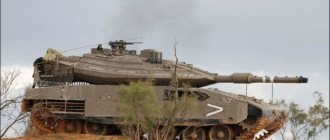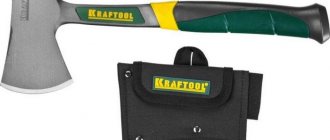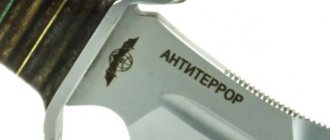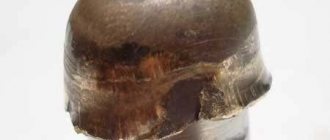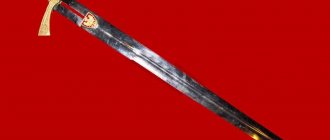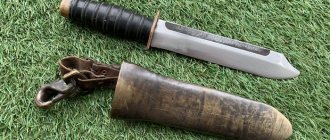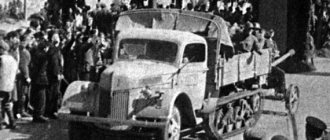Author: Winner56
04 February 2016 10:45
Tags: Russian knives ancestors
14843
11
Unusual national knives are typical for small nations living in specific natural conditions. Both the traditional knife of the indigenous peoples of the north, Ulu, made from slate, and the Malay parang, ideal for cutting a path in the jungle, fit this description.
0
See all photos in the gallery
Our Slavic ancestors, who inhabited the middle latitudes, preferred to carry multifunctional knives of simple design and medium size, which could be used both as a weapon and as a working tool. So, what kind of knives did our distant (and not so distant) ancestors have and which of them do we use now?
Guy's knife
0
Its name corresponds to its place of origin - the Kamchatka village of Paren. The design of the paren knife is very similar to the products common in Finland. Currently, the term “parensky knife” means a hand-forged knife with a blade made of heterogeneous composite material - they say that with parensky knives it was even possible to remove shavings from the blades of ordinary table knives. Today, the village of Paren has become a remote village, and the technology for making knives is considered lost - so those same Paren knives remain in people’s memory only in the form of legends. The knives now manufactured under this name have little in common with these legends.
×
The official version of the origin of shoemakers
They first started talking about boot knives at the beginning of the 19th century. At that time, they began to study “The Tale of Igor’s Campaign.” According to Apollo Maykov’s translation: “...warriors without shields with shoemakers win the regiment with a click.” It was in this passage that scientists found a direct reference to a weapon, possibly a knife, with which the princely squad fought.
We can assume that everything is explained in this passage, but there is one discrepancy here that the researchers could not have known about. To wield one knife in battle against warriors armed with swords, spears or axes was real suicide. No matter how masters of combat the ancient Slavs were, even they could not fight with knives alone.
"Cherry"
0
It’s also a 1943 model reconnaissance knife, also known as HP-43. The Cherry knife replaced the HP-40 army knife, which remained in service in the armies of the USSR and Warsaw Pact countries until the 60s. Why did this knife get the name “Cherry”? The fact is that on the guard of the knife there is a mark - the letter “P”, quite similar to this berry. "Cherry" is still in service with Russian security forces. Of course, from a later date of manufacture.
Geographical features of blade production
Ancient Rus'.
Ancient Rus' was a large state by the standards of the Middle Ages. Developed trade with neighboring countries and nationalities had a significant impact on the production of blades. Ancient Rus' closely coexisted with various nationalities.
Among them were the Balts, steppe nomadic tribes, Finno-Ugrians, Varangians, Greeks, Armenians, etc.
Slavic tribes dominated the area, but the culture of various nationalities was absorbed into the crafts of the regions.
This can be seen in the example of blacksmithing and knife production.
In general terms, the workshops of the school can be reduced to one two large categories: Kyiv and Veliky Novgorod. The differences in blacksmithing are due to the vast distance between these centers. Many historians argue that the term “Old Russian knife” is almost mythical.
The reason lies in the fact that there were no uniform standards for the manufacture of blades, and the products made in different places were very different. One can note the presence of northern and southern blacksmith schools. A little later, as a result of the development of blacksmithing, they merge.
Scout knife
0
Although edged weapons finally faded into the background by World War II, this did not negate the fact that a soldier needed to have a simple knife in his arsenal. But strange as it may sound, before the military actions taken by the Soviet Union against Finland, the Red Army did not have any special blade in service. And only after the end of the Finnish campaign, a significant event for Soviet soldiers occurred - the appearance of a scout knife of the 1940 model.
How shoemakers wore
Nowadays, boot knives are considered to be blades that were actually worn in boots. The boots were quickly put on, which was a very significant factor for warriors. The high tops seemed designed to conceal weapons.
Shoemakers were placed in three different ways:
- Often the sheath was sewn to the underside of the boots;
- Sometimes sheaths with knives were simply tied to one of the legs;
- At times, the knives could be located on the tops of some trouser legs.
The handles of the knives had to be hidden and invisible to outside observers. All this had to be done so that the owners of the knives could quickly remove them in cases of special need. Actually, this is what the lanyards were provided for. They could swing from the tops of their boots, which greatly simplified the removal of knives.
Underside knife
0
A combat knife or dagger with a long and narrow faceted blade was called a podsaidashny or podsadachny knife. Its name comes from where it is worn - under the saydak (bow case), on the side of the belt. That is why it is difficult to say exactly what shape these knives were - historians have the opinion that all large combat knives were called sideknives indiscriminately if they were worn on the belt under the sidek
Influence of neighboring peoples
Finno-Ugric and Scandinavian peoples influenced the northern school of blacksmithing. These peoples were excellent blacksmiths with their own original and interesting traditions. In turn, the northern region greatly influenced the development of Russian blacksmith traditions.
It was from there that the famous puukko knives and classic Scandinavian blades came from. The swampy terrain in the northern lands did not allow local residents to develop agriculture. Various crafts began to occupy a special place.
The Kiev, southern school was subject to European influence. She gained certain experience from the traditions of nomadic tribes and Tatars. Eastern influence explains the presence of crooked sabers, daggers and scimitars in the blacksmith culture of southern Rus'.
Eastern blades.
Mower
0
A mower, sometimes also called a “woman’s axe,” is a large utility knife with a wide and thick blade. It was usually made from a piece of a scythe (hence the name), and when the scythes stubbornly refused to break, from any scrap metal that came to hand. It’s safe to call a mower the Russian equivalent of a machete - this huge, rough knife is successfully used for cutting branches from felled trees, clearing grass from grassy fields, chopping bones, and even scraping the floor in a house.
Owl
By choosing this option, the hunter provides himself with reliable protection from the animal in the event of an attack. High quality and reliability are due to the following characteristics:
- steel hardness - 56-58 HRC;
- total length - 22 cm;
- handle material - birch bark;
- blade length - 11.5 cm;
- blade width - 3.3 cm;
- butt thickness - 2.4-3.4 mm;
- handle width (maximum value) - 3.7 cm.
The set includes a leather sheath-case.
Bogorodsky knife
0
The name of this carving tool comes from the village of Bogorodskoye - the center of traditional wood carving, whose symbol is the well-known toy - “Blacksmiths”, depicting a man and a bear who take turns hitting an anvil with hammers, you just have to pull the movable bar. The Bogorodsky knife has a straight short blade. Successfully used for both coarse and fine carvings. It is often made by carvers for themselves, so the design, shape of the handle and the cost of such knives can vary greatly.
Samsonov hunting knives
0
Yegor Samsonov was a modest Tula craftsman, but the knives and daggers he made were considered the standard hunting knives of the Russian aristocracy and were considered favorites of Emperor Nicholas II. After the death of the master in 1930, eminent metallurgists struggled for a long time over the mystery of the strength of the so-called “Samson knives”, which look so laconic and even ascetic, but the solution was never found. The exact number of knives produced by the workshop is unknown, according to some sources - 3356 pieces.
Russian squads in battle. Part 3
Saber, dagger and combat knife
It is widely believed that the saber was an integral part of the combat equipment of the Muslim warrior. However, it has been established that in the 7th – 14th centuries. among the Arabs and Persians, as in Western Europe, the straight sword reigned. The shape of the blade was similar to European designs, differing mainly in the handle.
The saber first appeared in the middle of the 1st millennium AD. e. in the steppe zone of Eurasia (the lands of Great Scythia, Sarmatia). Before this, straight swords and coinage predominated in the steppe zone. The oldest sabers are found in the territory from Hungary, the Czech Republic and the Northern Black Sea region to Altai and Southern Siberia. The first sabers were not very different from swords; the curve was slight. They differed in that the blade was sharpened on one side, but the upper part of the blade could be sharpened on both sides. In addition, the center of gravity of the saber is usually shifted towards the end of the blade. Such a blade was more suitable for a mounted warrior and allowed him to deliver slashing blows. With a slight curvature and a double-edged end, the saber was also suitable for a stabbing blow. In the Tale of Bygone Years, the saber is mentioned as a weapon of the Khazars and Pechenegs.
In Rus', archaeologists find sabers much less frequently than swords. Most of the finds are associated with Southern Russia, where the main military force was horse squads using fighting techniques and weapons of the steppe people. The earliest finds of sabers are associated with the Kiev region and Chernigov region. In particular, fragments of a saber were found in the Black Grave mound, the most famous druzhina burial in Rus'. Another saber was found in a burial ground near the village of Shestovitsa, near Chernigov.
Early sabers have a very slight bend in the blade, and it is even. They made sabers in much the same way as swords: there were blades made of the best types of steel, and there were simpler ones. Old Russian sabers are of the same type as Alan, Khazar, Pecheneg and Hungarian sabers and are not structurally different from them. Among the ancient Russian sabers there were also completely straight specimens; such a blade was found in the Vladimir burial mounds. To slightly reduce the weight of the blade, fullers were sometimes made on them. The crosshair of early sabers is small, often slightly bent towards the blade. There could be spherical protrusions at the ends of the crosshairs. The pommel of a saber is usually a hollow iron sleeve into which wooden handles are recessed. In the 10th-11th centuries, the length of the blade was about 1 m with a width of 3 - 3.7 cm. In the 12th century, the saber lengthened by 10-17 cm and reached a width of 4.5 cm, and its bend also increased. The same trends of change occurred among our neighbors - the Hungarians and Polovtsians. In the 13th century, which was characterized by the strengthening of the defensive weapons of warriors, sabers were weighted, like swords. By this time, the sabers had acquired their characteristic, immediately recognizable shape (the curve of the blade became more pronounced). They wore a saber in a sheath, either at the belt or behind the back, whichever was more convenient for them (swords were also worn in the same way). Few decorated sabers have been found in Rus', apparently due to the fact that the saber was not accompanied by such symbolism as a “fair” sword.
Sabers on a miniature of the Radziwill Chronicle of the 15th century.
It is interesting that Slavic craftsmen achieved high skill in making sabers and contributed to its penetration into Western Europe. So, according to experts, it was the Slavic and Hungarian masters in the late 10th and early 11th centuries. made a masterpiece of weapons art of that time - the so-called. Charlemagne's saber, which became the ceremonial weapon of the Holy Roman Empire. In general, in Western Europe, the saber entered mass military use much later than Rus': in France - in the mid-13th century, in Serbia - in the 14th century, in Germany by the 16th century. In addition, the Slavic name for this weapon entered many European languages, including French and German.
Saber of the 12th century, Eastern Europe.
In addition to swords and sabers, Russian warriors were armed with combat knives and daggers. With the advent of the Varangian Rus in Rus', the so-called. “skramasaks”, long (up to half a meter), narrow (2-3 cm) combat knives. They were distributed in the territory from Northern France and Germany to Scandinavia. Judging by the surviving images, they were worn in a sheath, which was located horizontally along the warrior’s belt, with the blade up. However, these combat knives are already from the 9th – 10th centuries. archaic. Finds of such knives are few and far between around the 11th century. they disappear completely.
Daggers in Rus' are even less common than skramasaks. The main difference between a dagger and a combat knife is its double-sided sharpening. The earliest daggers found in Rus' date back to the turn of the 10th-11th centuries. One blade was found in Novgorod, the other in Beloozero. The length of their blades is about 30 cm. Researchers report that daggers became part of the equipment of knights on a larger scale in the 13th century, during the era of strengthening defensive weapons. The dagger was used to defeat an enemy protected by armor during close hand-to-hand combat, or to finish off an enemy. Russian daggers of the 13th century are in many ways similar to European ones; they have the same elongated triangular blade.
“Combat” knives (researchers call all knives more than 20 cm long) were owned by all Russian men, and many women as well. Obviously, they had a dual purpose, both as part of combat equipment and as an economic function. Written sources report the use of a knife in heroic duels, when finishing off the enemy and during the most fierce, stubborn battles. In Rus', knives were actually an item of clothing and accompanied the owner even after death; in the burials of the Slavs - both men and women, a knife is a mandatory attribute. The knife, as a symbol of the hearth, was given by the groom to the bride at the wedding.
Modern reconstruction of an ancient Russian knife, made by the workshop of V. Mikheev (Izhevsk).
Knives from Novgorod excavations, dating from the 14th-15th centuries.
A spear
Judging by archaeological data, the most popular types of weapons were those that could be used not only in battle, but also in hunting and farming. These are a bow, a spear, a knife and an ax. Spearheads are found in burials, at battle sites, and in large numbers; they are second only to arrowheads. In addition, in terms of its antiquity, the spear as a weapon is quite comparable to an ax and has been known to the Slavs since time immemorial.
The Old Russian spear consists of two parts: the spear itself (iron tip) and the shaft, or warrior. Archaeologists identify spearheads from the period IX - XIII centuries. seven main types. Warrior's spear shaft 9th – 10th centuries. slightly exceeded the average height of a person and reached 1.8 - 2.2 m. A socketed tip from 25-28 cm to half a meter in length (together with bushing). In turn, the tip consisted of a feather (the piercing-cutting part) and a sleeve. The tip was attached to the shaft with a nail or rivet. The shapes of the tips varied, but elongated triangular ones predominated. Sometimes they were found in the form of a lancet (surgical knife). The thickness of the tip was up to 1 cm, width up to 5 cm. Both cutting edges were sharpened. The spear shaft was sometimes additionally protected by a metal coating to make it more difficult to cut through.
Contrary to popular opinion, such spears were not thrown in battle (it is clear that there were exceptions). The spear was a piercing weapon for hand-to-hand combat. Sometimes a spear could also be a cutting weapon. Spears, like axes, were decorated relatively rarely. Sometimes decorative grooves were cut into the bushings.
To throw at the enemy, they used a special type of spear - “sulitsa” (javelin-dart). The name of the spear came from the word “promise”, meaning “to poke”, “throw”. The sulitsa was a cross between a spear and an arrow. The length of the shaft reached 1.2 - 1.5 m, the iron tip - 15-20 cm. The tips were most often not socketed, but petioled and attached to the shaft from the side, entering the tree only with the lower curved end. It was a typical "disposable" weapon, usually lost on the battlefield. In terms of prevalence, the spear-spear was the second weapon of distance combat after the bow. A warrior could have several souls. The maximum effect in the use of sulits was achieved when, at the beginning of the battle, the warriors threw them at the enemy with the entire squad. In addition, there were units of lightly armed warriors, whose main weapons were sulitsa, they began the battle. Sulitsa were also used en masse in the defense of fortifications, when pre-created reserves could be used. Apparently, when setting out on a campaign, Russian soldiers carried the sulitsa in disassembled form and mounted the tips on the shaft before the battle. In the story about the massacre on the Pyana River (it happened two years before the Battle of Kulikovo) it is reported: “They made a mistake and neglected the hozhahu, their armor was put on carts in the warehouse, and others were put in bags, and some of the sulitsi had not yet mounted the byahu, but shields and the spears are not prepared...”
Archaeologists divide sulitsa into two groups: combat - equipped with a narrow and strong tip that could pierce armor and penetrate deeply into the body; hunting - with wider tips. The sulitsa, in addition to its main use, could also play a supporting role - stuck in the enemy’s shield, the sulitsa hampered his movement and ability to maneuver, and increased his vulnerability. In exceptional cases, the sulitsa could serve as a piercing weapon in close combat.
Modern reconstruction of the sulitsa tip.
Another type of Russian spear was the rogatina (rogatina) - a Slavic heavy, powerful spear for hand-to-hand combat or for hunting large animals. The appearance of the spear dates back to the 12th century, when tips of a special kind began to be found. Their weight reached about 700-1000 g, while the weight of ordinary copies was equal to 200-400 g. The width of the pen was 6 - 7 cm, thickness up to 1.5 cm, blade length - up to 30 cm. The length of the tip itself ( together with the sleeve) reached 60 cm. The tips were with a laurel-shaped feather. In the hands of an experienced warrior, it was a terrible weapon, capable of piercing the strongest armor, or stopping a large and dangerous animal - a bear, aurochs or wild boar. Such a tip caused a wide and deep wound. When striking, the horned spear was held with both hands. In the Russian army, slingshots were used until the end of the 17th century. Later they were used mainly only as hunting weapons.
Spearhead tips.
The tip of the spear of the Tver prince Boris Alexandrovich, around 1450.
Another specialized type of Russian spear is the pike. The pike had a narrow tetrahedral or triangular tip, capable of successfully piercing the enemy’s armor. The pike was intended only for war. The bushing of the pike is not wide, the shaft is thin. True, the peak became widespread in Russia only from the end of the 17th century. Its short version was in service with the Cossacks, lancers, cuirassiers, and hussars.
Axe
Competing with the spear in terms of popularity was the axe, another type of weapon that has gone with man since primitive times. The ax appeared when a person realized how much power a blow can be given by attaching a pointed stone to a stick. Later, stone axes were replaced by bronze and then iron.
Despite their popularity compared to the sword, the ax and types of weapons related to it based on the principle of action (hammer, mace, etc.) were no less surrounded by legends and traditions. In many ancient cultures, the ax or its relatives were the weapon of the thunder god, thunder god, warrior god, and patron of warriors. In particular, the Scandinavian Thor is armed with the hammer Mjollnir (“Lightning”). A miniature image of this hammer was a popular amulet against evil forces. Apparently, one of Perun’s main weapons was an ax. In Rus', pendants-symbols of Perun were in fashion in the form of hatchets decorated with circles - symbols of the Sun. It should be noted that solstice symbols (swastikas) have been part of Russian culture since ancient times and existed in Russian culture, including on icons and in embroidery, until the beginning of the 20th century. Interestingly, pendants-symbols of Perun existed after the baptism of Rus'; they were worn mainly by future warriors - boys and young men. Decorated hatchets could serve as symbols of power, and were sacred objects in the pagan era.
An ax, like a knife, could perform both combat and economic functions during a campaign. At the same time, there were exclusively battle axes, in particular chased hatchets - small narrow hatchets, the butt of which was made in the form of a hammer. Sometimes instead of a hammer there was a pecker. Hammered hatchets were small in size and had exclusively military purposes. Typically, the total length of such a hatchet was 12.5-19 cm (without a hammer - 8-15 cm), blade width was 3-6 cm, sleeve diameter 1.8-2.7 cm, weight 200-340 g. Light weight This hatchet made it possible to deliver quick and accurate blows. Hammered hatchets have an ancient history and were known to the ancestors of the Slavs - the Scythians, back in the 1st millennium BC. e., later they were used by the Sarmatian-Alan tribes.
Another type of battle ax was the coined one. Coined weapons were called cold weapons, the warhead of which was made in the form of a beak, secured with an eye on the handle. The task of the coin was to pierce and cut through the enemy’s armor.
Another type of battle ax was klevets - crushing and piercing edged weapons. Its warhead was made in the form of a narrow, straight or bent point. The back part was often shaped like a hammer, which balanced the weapon and made it possible to use it to stun an enemy or for crushing blows. The ax handle was straight, 60-80 cm long, total weight - 1 - 1.5 kg. Klevets had high penetrating ability, breaking through any armor and shields since a strong blow fell on a small area. However, his weak point was that he often got stuck in what he punched, and it was difficult for him to defend. Therefore, it was usually an auxiliary weapon to the sword.
It must be said that the battle ax, being a multifunctional striking and chopping weapon, had many varieties. Battle axes were one-handed and two-handed, one-sided and two-sided. The ax could be used both for close combat and for throwing. For foot soldiers, the ax was often the main weapon. For horsemen it was an auxiliary weapon. Foreigners noted that the Russians were massively armed with axes, which were an effective weapon both against the steppe people and against the Europeans. The ax had great penetrating power, which made it possible to disable men-at-arms and war horses that had protective equipment. Even if the ax did not penetrate the armor, it injured the enemy, stunned, and shocked him.
In Rus' they also used axes, which are often attributed to the Scandinavians. They were distinguished by a large ax - up to 1 meter. The length of the blade was 17-18 cm, sometimes up to 22 cm, and the width was approximately the same. Weight – 200 – 450 g. For comparison, the weight of a peasant ax was 600 – 800 g. The myth of “huge axes” was created by the creators of feature films and books. A “huge” ax, which requires two hands to strike, is good for chopping wood, but not for hitting. Such an ax really delivers a terrible blow, but there are more disadvantages - loss of maneuverability, greater strain on strength (it is difficult to swing it for hours, and the battle could last a day or more), worse opportunities for defense. Russian warriors preferred “light axes.”
Battle axes X - XIII centuries. Samples of basic forms.
Battle axes X-XIII centuries. Typological scheme. Source: Kirpichnikov A. N. Old Russian weapons.
Scientists call “Russian-Finnish” (they are most often found in the north of Rus') axes with a characteristic straight upper edge and a blade pulled down. Rus' also developed its own, “national” type of battle axes. Their design is very rational and perfect. Their blade is slightly curved towards the bottom, which achieves not only chopping, but also cutting qualities. The shape of the blade was such that the efficiency coefficient approached unity: all the power of the blow was concentrated in the middle part of the blade, so the blow was crushing. On the sides of the butt there were small appendages called “cheeks”; the back part was also lengthened with special “toes”. They protected the handle when a stuck ax had to be swung after a strong blow. Since the 10th century, such axes became the most popular in Rus'.
Old Russian poleaxe (axe) X-XIII centuries. Modern reconstruction.
To be continued…
Finca
0
In Russia, the knife, which came to us from Finland, was for a long time considered exclusively a weapon of criminal elements and was even banned until 1996. However, its true purpose is completely different. The Finnish knife is multifunctional, it is perfect for cutting meat, cleaning fish, and is indispensable on a hike and for household needs. The Finnish blade is characterized by a short straight blade, a bevel of the butt like a clip-point or “pike” in Russian, and a mounted handle.
Legal aspects of using cobblers
In accordance with the Russian federal legislation “On Weapons” and state standards defining the types of knives, traditional boot knives are classified as civilian edged weapons. Their circulation in our country has restrictions. According to government decree, wearing boot knives is permitted only with Russian costumes (red blouses, chrome boots, sashes and caps). This is allowed to members of Russian societies who are included in the register of Russian societies of the Russian Federation and have the appropriate certificates and permits to purchase and carry bladed weapons.

